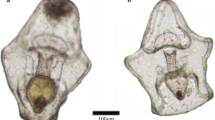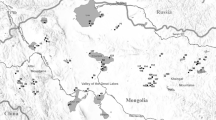Abstract
We determined seasonal foraging modes of four sympatric darter species, Etheostoma lynceum, E. stigmaeum, E. swaini and Percina nigrofasciata, from Beaverdam Creek, Mississippi (USA) at two scales of taxonomic resolution: (1) chironomid prey identified to family and (2) chironomid prey identified to genus/species. When chironomids were identified to family, high proportional similarity (PS) and low niche breadth (NB) values suggested the darters fed opportunistically on a relatively small number of available prey taxa. In contrast, when chironomids were identified to genus/species, concordant low PS and NB values suggested the darters fed like classic specialists, selecting a small number of prey taxa relative to prey availability in the resource base. The darters selected just one to four chironomid taxa from 52 available taxa across seasons. Our study shows that the scale of taxonomic resolution used to identify darter prey may influence the characterization of darter foraging modes.




Similar content being viewed by others

References
Benke AC, Henry RL III, Gillespie DM, Hunter RJ (1985) Importance of snag habitat for animal production in southeastern streams. Fisheries 10:8–13
Brower JE, Zar JH, von Ende CN (1997) Field and laboratory methods for general ecology, 4th ed. McGraw-Hill, Boston, MA. 273 pp
Chesson J (1978) Measuring preference in selective predation. Ecology 59:211–215
Cordes LE, Page LM (1980) Feeding chronology and diet composition of two darter (Percidae) in the Iroquois River system, Illinois. Am Midland Nat 104:202–206
Dickman CR (1986) Niche compression: Two tests of an hypothesis using narrowly sympatric predator species. Aust J Ecol 11:121–134
Epler JH (1995) Identification manual for the larval Chironomidae (Diptera) of Florida: final report for DEP contract number WM579. Florida Department of Environmental Protection, Tallahassee, FL, 317 pp
Feinsinger P, Spears EE, Poole RW (1981) A simple measure of niche breadth. Ecology 62:27–32
Glasser JW, Price HJ (1988) Evaluating expectations deduced from explicit hypotheses about mechanisms of competition. Oikos 51:57–70
Hershey AE (1987) Tubes and foraging behavior in larval Chironomidae: implications for predator avoidance. Oecologia 73:236–241
Hershey AE, Dodson SI (1985) Selective predation by a sculpin and a stonefly on two chironomids in laboratory feeding trials. Hydrobiologia 124:269–273
Hlohowskyj I, White AM (1983) Food resource partitioning and selectivity by the greenside, rainbow, and fantail darters (Pisces: Percidae). Ohio J Sci 83:201–208
Knight JG, Ross ST (1994) Feeding habits of the Bayou Darter. Trans Am Fisheries Soc 123:794–802
Krebs CJ (1989) Ecological methodology. Harper and Row, New York, NY, 654 pp
Lawlor LR (1980) Overlap, similarity, and competition coefficients. Ecology 61(2):245–251
Layzer JB, Reed RJ (1978) Food, age, and growth of the tesselated darter Etheostoma olmstedi, in Massachusetts. Am Midland Nat 100:459–462
Levins R (1969) Some demographic consequences of environmental heterogeneity for biological control. Bull Entomol Soc Am 15:237–240
Manly BFJ, McDonald LL, Thomas DL (1993) Resource selection by animals: statistical design and analysis for field studies. Chapman and Hall, London. 240 pp
Martin FD (1984) Diets of four sympatric darter species of Etheostoma (Pisces: Percidae) from southern Indiana: interspecific and intraspecific multiple comparisons. Environ Biol Fishes 11:113–120
Mathur D (1973) Food habits and chronology of the blackbanded darter Percina nigrofasciata Agassiz, in Halawakee Creek, Alabama. Trans Am Fisheries Soc 102:48–55
Matthews WJ, Bek JR, Surat E (1982) Comparative ecology of the darters Etheostoma podostome, E. flabellare, and Percina roanoka in the Upper Roanoke River drainage, Virginia. Copeia 1982:805–814
Merritt RW, Cummins KW (1996) An introduction to the aquatic insects of North America, 3rd edn. Kendall/Hunt Publishing, Dubuque, IA, 862 pp
Page LM (1983) Handbook of Darters. Publications TFH, Neptune City, NJ, 271 pp
Paine MD,Dodson JJ, Power G (1982) Habitat and food resource partitioning among four species of darters (Percidae: Etheostoma) in a southern Ontario stream. Can J Zool 60:1635–1641
Phillips EC, Kilambi RV (1996) Food habits of four benthic fish species (Etheostoma spectabile, Percina caprodes, Noturus exilis, Cottus carolinae) from northwestern Arkansas streams. Southwestern Nat 41:69–73
Rachlin JW, Warkentine BE,Pappantoniou A (1989) The use of niche breadth and proportional similarity in feeding to stipulate resource utilization strategies in fish. J Freshwater Ecol 5:103–112
Rakocinski CF (1991) Prey-size relationships and feeding tactics of primitive stream-dwelling darters. Can J Fisheries Aquat Sci 48:681–693
Rakocinski CF (1997) Interactive effects of darter predation and elevated discharge on macroinvertebrates of a Gulf Coast stream. J Freshwater Ecol 12:341–354
Ross ST (1986) Resource partitioning in fish assemblages: a review of field studies. Copeia 1986:352–388
Ross ST (2001) The inland fishes of Mississippi. University Press, Jackson, MS. 736 pp
Ross ST, Baker JA, Clark KE (1987) Microhabitat partitioning of southeastern stream fishes: temporal and spatial predictability. In: Matthews W, Heins D (eds) Community and evolutionary ecology of North American stream fishes. University of Oklahoma Press. Norman, OK, pp. 42–51
Schenck JP, Whiteside BG (1977) Food habits and feeding behavior of the fountain darter, Etheostoma fonticola. Southwestern Nat 21:487–492
Schlosser IJ, Toth LA (1984) Niche relationships and population ecology of rainbow (Etheostoma caeruleum) and fantail (E. flabellare) darters in a temporally variable environment. Oikos 42:229–238
Sih A, Moore RD (1990) Interacting effects of predator and prey behavior in determining diets. In: Hughes RN (ed) Behavioral Mechanisms of Food Selection. NATO ASI series, volume G 20, Springer Verlag, Berlin, pp 771–796
Slack WT (1996) Fringing floodplains and assemblage structure of fishes in the Desoto National Forest, Mississippi. Ph.D. Dissertation, The University of Southern Mississippi, 91 pp
Smith EP (1985) Estimating the reliability of diet overlap measures. Environ Biol Fishes 13:125–138
Strange RM (1991) Diet selectivity in the johnny darter, Etheostoma nigrum, in Stinking Fork, Indiana. J Freshwater Ecol 6:377–381
Strange RM (1993) Seasonal feeding ecology of the Fantail darter, Etheostoma flabellare, from Stinking Fork, Indiana. J Freshwater Ecol 8:13–18
Strange RM (1997) Food items of Channel darters (Percina copelandi) collected from the Ohio River. J Freshwater Ecol 12:339–340
Wehnes RE (1973) The food and feeding interrelationships of five sympatric darter species (Pisces: Percidae) in Salt Creek, Hocking County, Ohio. M.S. Thesis, The Ohio State University, 62 pp
Wiederholm T (1983) Chironomidae of the Holarctic region: keys and diagnoses. Entomologica Scandinavica: Supplement 19(1983):1–457
Acknowledgements
We are grateful to C. F. Rakocinski and S. T. Ross for contributing to the development of this paper and the Department of Biological Sciences at the University of Southern Mississippi for supporting this research. We are thankful to M. L. Gullett, J. G. Himes, A. T. Lee, M. T. O’Connell, P. Schweizer, A. Wilberding and E. J. Wong for their assistance with field collections.
Author information
Authors and Affiliations
Corresponding author
Rights and permissions
About this article
Cite this article
Alford, J.B., Beckett, D.C. Selective predation by four darter (Percidae) species on larval chironomids (Diptera) from a Mississippi stream. Environ Biol Fish 78, 353–364 (2007). https://doi.org/10.1007/s10641-006-9159-4
Received:
Accepted:
Published:
Issue Date:
DOI: https://doi.org/10.1007/s10641-006-9159-4



